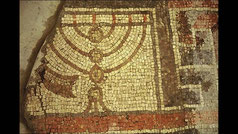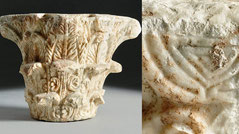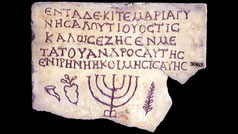ANCIENT AND NEW MENORAHS - 3rd Century AD / CE
This website shows ancient Menorahs from the third century. Menorah illustrations from other centuries: Ancient Menorahs until the 1st century, 2nd century, 4th century, 5th century, 6th-10th century, 11th-13th century, 14th century, 15th century, 16th century, 17th century, 18th century, 19th century, 20th century, 21st century and Coins.

3rd-6th century. Ancient medallion with Jewish symbols incl. menorah. Byzantine Empire. 6cm diameter. The Jewish Museum London. Please see also the gold medallion from the 7th century (10cm diameter). Source: Link

3rd-4th century. Gold ring with menorah. Intaglio 9x11x3 mm; ring diam. 19x16 mm; gr. 5,58. A rare, roman nicolo intaglio, mounted in an ancient gold ring. Menorah. The seven-armed chandelier ends with a three-edged base (the tripode base typology can be observed in numerous coeval artifacts, for ex. Mosaics, relief depictions on engravings on stone or marble). Besides, we can see some attributes: a bunch of grapes and a small horn (shofar) on the left; a leafy branch on the right. Link
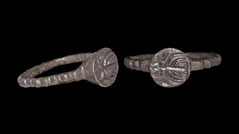
3rd century. Roman Ring with Menorah. A bronze finger ring with beaded outer face, discoid bezel with intaglio menorah symbol. Size: 4.51 grams, 27.23 mm overall, 20.27 mm internal diameter (approximate size British U 1/2, USA 10 1/2, Europe 23.59, Japan 22) (1"). From a home counties collection; formed 1970-1980. LiveAuctioneers, 2018 Lot 0831. Source: Link

3rd-7th century? (Age was not specified at the source). Lead Tesserae, Judaea. Seven-armed candlestick (menorah) between shofar (?) on the left and palm branch on the right, with Greek legends fragments above. Reverse: Smooth surface without embossing. 16 mm. 2.10 g. Solidus. Source: Link

200-400 AD. Ancient Roman ignostic stone pendant with menorah. Dimensions: 26 X 21 X 8 MM. Source: Link

200-400 AD. Hebrew-Roman. Lot of two superb "glass Menorah pendants". First a white tiny glass seven branch menorah with some iridescence throughout with translucent body. Dimensions: 16 x 1.5 mm [0.8 grams]. Also a nice mauve pendant with loop depicting 7 branch Menorah. Heavy deposit with attractive very nice iridescence on both sides. Size: 24 mm [2,7 grams]. Montreal Collection. LiveAuctioneers, 2008 Lot 0195. Source: Link

3rd-7th century? (1st millennium). Near Eastern Judaic Glass Menorah Pendant. A discoid pale amber glass pendant with integral loop, raised menorah motif to one face. 6.02 grams, 29mm (1 1/4"). From an important London collection. Live-Auctioneers, 2014, Lot 213. Source: Link
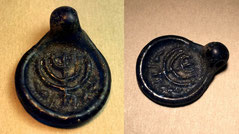
200-400 AD. Roman – Byzantine glass Menorah pendant. Dark blue color glass stamped with an image of the Menorah. Length including loop: 2.2 cm. Provenance: Private collection, NYC. Source: Link

3rd-6th century AD. A rectangular bronze stamp with raised rim, Jewish symbols in raised relief, including a large seven-branched menorah on a tripod base at the centre, a shofar to the left, a lulav and shovel to the right; loop handle to the reverse. LiveAuctioneers, Lot 0154, 2019. Source: Link
For several similar examples see the stamps from the 4th century.
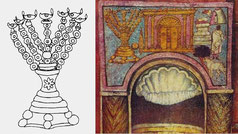
245-246 AD. The earliest example of Jewish narrative art, the synagogue murals at Dura Europos. The crowning facade of the Torah niche features a large menorah with seven straight arms radiating from a massive base, quite unlike any menorah image of its time. Source: Link1, Link2, Link3, Link4, Link5, Link6
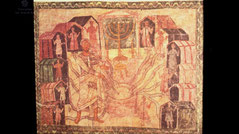
245-246 AD. Dura Europos Synagogue, Syria. Wall painting with menorah. Moses wearing a toga touches the stone in the Sinai to bring forth water. Copyright: Center for Jewish Art. Link1 Link2 Link3 - "This startling discovery contains dozens of images of Biblical scenes which were strictly prohibited by the 2nd of the 10 Commandments. There is no need to marvel however because this "synagogue" is not Jewish at all but a fake Samaritan imitation, the veritable synagogue of Satan". Link1, Link2

3rd-5th century. Ancient menorah mosaic in Sepphoris (Zippori) which was a major Roman and Byzantine city, the capital and heart of the Galilee province. The synagogue was a refuge for Jews pushed out of Jerusalem after the fall of the 2nd Temple. Source: Link

3rd-6th century. Tiberias (Galilee) became an important Jewish city and several synagogues were built in Hammath. The Ark of the Covenant flanked by 2 menorahs. There are also other cult objects: 4 species from the feast of Tabernacles/Sukkot, pair of horns and incense shovels. The panel representing the pagan zodiac wheel with Helios and the seasons, is situated at the center of the nave, between the panels of the sanctuary implements to the south. Link1, Link2, Link3, Link4, Link5

3rd-6th century. Ancient Ein Gedi's Ancient Synagogue mosaic detail. A seven-branched menorah graces the synagogue mosaic floor. A Hebrew and Aramaic inscription in the left aisle lists the 13 forefathers of mankind, the 12 signs of the zodiac, thanks the benefactors and curses community members who do not keep the rules of the village. Archeologists believe that the settlement came to the end by the late 6th century. Source: Link1, Link2

3rd century. Unique restored foor mosaics from the Antiquity Synagogue in ancient Philipopolis, Bulgaria’s Plovdiv, depict a large menorah. Bulgaria’s only Jewish temple from the Antiquity period, have been restored by the Plovdiv Museum of Archaeology. Photo: 24 Chasa daily. Source: Link1, Link2, Link3

250-410 AD. Gold glass fragment depicting a menorah. Provenance: Rome. Material: glass, gold. ©2018 University of Oxford, Ashmolean Museum. Source: Link

3rd–4th century. Bronze Hook for an oil lamp, decorated with a menorah. Khirbet Wadi Hamam (near the sea of Galilee). Israel Antiquities Authority. Accession number: IAA 2011-972. Photo © The Israel Museum, Jerusalem. Source: Link1

Various oil lamps with a Menorah. See: Ancient Menorah Oil Lamps - 3rd Century

3rd-5th century. Ancient tombstone. Copy of a marble revetment plaque with Menorah, Lulav and Ethrog found not far from the Synagogue in the Agora of Athens. This copy was made through the assistance of Prof. Homer Thompson, Field Prof. Emeritus of the Agora excavation. The original is in the Agora. The Jewish Museum of Greece. Source: Link1, Link2, Link3, Link4
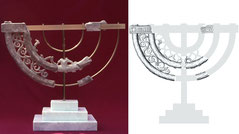
3rd-4th century. Marble menorah from the Synagogue in Sardis, Turkey. Freestanding marble menorah may have stood nearly 1 m high. Its seven thick branches support an incised crossbar with an inscription identifying Socrates, perhaps the name the donor. Sardis was the capital of the ancient kingdom of Lydia, one of the important cities of the Persian Empire, the seat of a proconsul under the Roman Empire, and the metropolis of the province Lydia in later Roman and Byzantine times. Link1, Link2

3rd-4th century. Marbe plaque from the Synagogue in Sardis, Turkey. The menorah or multi-branched candelabrum was an important part of the Synagogue’s interior furnishings. The largest is a rectangular relief panel of a menorah with flanking lulav and shofar, which may have belonged to a low barrier or screen. ©Archaeological Exploration of Sardis / President and Fellows of Harvard College. Source: Link1, Link2, Link3, Link4

3rd-4th century. Ancient marble plaque from the synagogue of Andriake (Andriace), Turkey. The iconography of the menorah-spirals beneath each branch, palm frond and citron to its left, and a shofar to its right-is clearly Jewish and fits with the other menorahs with curls from Nicaea, Sardis... (Please see also a similar stone from Sobrarbe, Spain from 12th-14th century). Source: Link1, Link2, Link3

3rd-4th century. Marble Burial Plaque. On an elegantly carved marble from the Vigna Randanini catacomb in Rome, a menorah illumines the tabula ansata above. This frame enclosed a now-faded epitaph. The familiar cult object - ethrog (citron), shofar, vessel, lulav (palm) - surround the sacred lampstand. Dimensions: 11 5/8 × 10 7/16 × 1 3/16 in. (29.5 × 26.5 × 3 cm). Image Copyright: © The Jewish Museum, New York. Source: Link1, Link2, Link3, Link3

3rd-4th century. Ancient sarcophagus fragment from Israel (?). Carved marble, showing a seven-branched menorah. 16 9/16 x 21 7/8 x 2 3/8 in. (42 x 55.6 x 6 cm). The Jewish Museum, New York. Source: Link
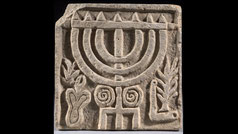
3rd-5th century. This ancient relief was found in the floor of the church at the Theater of Priene (ancient Greek city, today Turkey), but it is from an older building, probably from the synagogue found further downhill on Westgate Street. Menorah on a tripod, Torah scrolls, lulab, ethrog, shofar. Museum für Byzantinische Kunst, Preußischer Kulturbesitz, Berlin, Germany. Source: Link1, Link2, Link3, Link4, Link5

3rd-4th century. Ancient Priene Synagogue. The Menorah is flanked by two peacocks. The arms were connected by a transverse rod. On the right is a Lulav. Marble slab. Dimensions: 77 x 61 x 9 cm. Source: Picture from the German Book "Im Licht der Menora. Jüdisches Leben in der römischen Provinz" 2014.

3rd-5th century. A lintel from Sarona (Galilee) is decorated with birds flanking a menorah. This is the only other example of such a representation known to us from Palestine. A relief showings birds flanking a menorah was found in Priene in Asia Minor, and in one of the catacombs in Monteverde, Rome, and on an ossuary in Spain. Birds are on both sides of the Torah shrine in the Beth Alpha mosaic or on gold glass from Rome. Period: Late Roman and/or Byzantnine. Link1, Link2, Link3

3rd-4th century. Ancient 600 kilogram heavy gravestone with menorah from Esztergom-Solva in Hungary. 148 cm. Transcription according to Alexander Scheiber: "MEMORIA IVDATI PATIRI/ ET MEMORIA KAÇÇIE / EUL" = "Memorial for Juda, the father, and memorial for Kassia. Blessing!" Below, a three-footed menorah with rounded branches and indication of the light fittings on the cross-bar. Jewish Museum, Budapest. Source: Link1, Link2, Link3, Link4, Link5, Link6, Link7

3rd century. Nawa, lintel of a Jewish house (probably built in the 3rd century AD) with 2 seven-armed candlesticks (menorah, Jewish symbol of God's presence, light, tree of life, eternal life) and tendril ornaments. Today the house is used as a stable. East foothills of the Golan, west of Shaykh Mishkin (Syria, southwest Syria, Dera). Nawa, Dera, Syria. AKG-Images. Source: Link

3rd-5th century (?). Korykos (Latin Corycus; Turkish: Kızkalesi; Region Cilicia) was an ancient Greek city, now in Turkey. The tomb inscriptions of the necropolises shows that at least from the Roman period in the city a noteworthy Jewish community existed. In 1931, Keil and Wilhelm identified among the over 500 inscriptions published by them ten of Jewish origin. Criteria were initially an engraved menorah and the names Ioudaios or Εβρέος (Hebreos). Link1 Link2 Link3 Link4 Link5 Link6

3rd-5th century (?). Necropolis at Korykos (lat. Corycus, modern Kızkalesi, southern Turkey, lintel with seven-branched chandelier in the northern wall of a warehouse building. Ancient Cilicia’s Jewish population is mentioned several times in Acts of the Apostles and the writings of Paul in the New Testament. Ancient inscriptions likewise bear witness to a strong Jewish presence in Cilicia. Tarsus (birthplace of Paul the Apostle) was the capital of the province of Cilicia. Link1, Link2, Link3, Link4

3rd-5th century (?). Necropolis in Korykos (Corykos; Latin Corycus; Turkish: Kızkalesi; Region Cilicia, now in Turkey). Sarcophagus with Menorah. This necropolis includes people of different faiths with no specific burial areas set aside for the sole use of Jews, Christians or of Pagans and in consequence the symbols of different faiths are found adjacent to each other. Source: Link1, Link2, Link3

3rd-5th century (?). Menorahs in memoriam. An ancient necropolis at Korykos (modern Kızkalesi, Turkey) contains at least 12 epitaphs of Jews buried there. Two sarcophagi (and possibly more) nearby bear large menorahs to identify the people entombed within as Jews. The sarcophagus lid pictured below displays two menorahs, one on the far left and one on the right. Mark R. Fairchild. Source: Link1, Link2

3rd-6th century. Jewish presence at Limyra, Turkey. Limyra, an ancient Lycian city is located in the Finike province of the Antalya. In a building recently excavated by Martin Seyer, chancel screens with Jewish symbols - menorahs, a shofar and a Lulav (palm branch) - have been uncovered. In a later period, these screens were broken and reused as paving stones. Source: Link1, Link2, Link3

3rd-5th century (?). A Menorah on a Jewish tombstone from north central Turkey, now in the Boğazköy Museum (photo © Daniel C Browning Jr). Source: Link

3rd-7th century. Front and back of a Fragment of a Synagogue Screen. Made in Israel, found at Ashkelon. Marble. During the Byzantine period, Jewish life was centered in the holy land in a mostly rural society oriented around synagogues, which served as places of communal gathering, study, and prayer. Source: Link
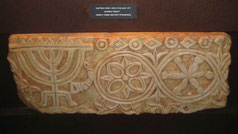
3rd century. Ancient marble relief with Menorah from the synagogue at Ashkelon. Source: Link

3rd-6th century. Architectural fragment of the Yehudiya Synagogue. The block is decorated with a nine-branched menorah with a three-legged base, flanked by a shofar and an incense shovel. The semi-circular branches are each topped with a ball-like projection (lamp or flames). Center for Jewish Art. Source: Link1, Link2
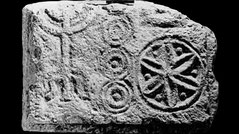
3rd-6th century. Stone door fragment from a "synagogue" in Galilee. Menorah together with pagan symbols. "The 6 pointed star comprising 2 pyramids is an ancient sun worship symbol. It is an adaptation of the pagan rosette or wheel symbol. The Samaritans brought that symbol from their homes in Babylon and it is found in many of the Samaritan synagogues." Image from the book "Jewish Symbols in the Greco-Roman Period," volume 7. Source: Link In Israel there are true Jews and other folk.

3rd-4th century. Menorahs Flanking Ark of the Covenant, fresco Courtesy Catacombs of Villa Torlonia, Rome (Jewish catacombs of Venosa Vigna Randanini). "What is fascinating is the abundant use of this symbol, evidently as an eschatological sign in conjunction with an imagined Third Temple facade, in an unseen secret underground graveyard." Source: Link1, Link2

3rd-5th century. Hanukkah depicted in the Catacombs of Venosa (Catacombe ebraiche di Venosa). The Jewish Catacombs of Venosa are a set of catacombs located near the Italian city of Venosa, Province of Potenza, on Maddelena Hill. Most of the names listed in the catacombs reflect the tendency of Jewish diaspora to take Greek or Latin names as opposed to names in Hebrew, with only a small minority of the people buried there having names reflecting a Hebrew etymology. Link1, Link2

3rd-5th century. Catacombe Ebraico-Cristiane of Venosa. Dated between the 3rd and the 7th century AD they were discovered in 1853. They document the presence of a thriving local Jewish community between late antiquity and the early Middle Ages. The Jewish community, whose original nucleus was probably Hellenistic, as can be seen from the epigraphs, was for the most part made up of merchants and landowners. Epitaphs in Latin, Hellenistic Greek and Hebrew. Source: Link1, Link2

3rd-4th century. The Jewish Lapidarium includes a collection of ancient grave inscriptions. The Lapidarium was transferred from the Lateran Palace to the Vatican in 1963 along with the early Christian collections. It includes almost all the inscriptions (around two hundred) discovered during the excavation of the Jewish catacomb of Monteverde on the Via Portuense. The signs of the mostly Greek-speaking Jewish community in the diaspora are menorah, lulav and etrog. Source: Link

3rd-4th century. White marble grave stone of Aster (a Hellenized form of Esther meaning star) from the Jewish Monteverde catacomb (Rome, Italy). It was found on December 20, 1904. The inscription is carved and painted red, with birds, trees, flask, grapes, menorah. Musei Vaticani, Lapidario Ebraico, Citta del Vaticano. Source: Link1, Link2, Link3, Link4, Link5

3rd-4th century. Epitaph, grave stone of Salutia. This fragmentary marble slab originally sealed a loculus or niche tomb in the Jewish catacomb of Monteverde, near the ancient Via Portuense (Portuensis). The Latin alphabet is used, in contrast to the clear preponderance of Greek inscriptions, although the use of Latin names is common in the Jewish community. Menorah and open scroll or book (Bible?). Città del Vaticano, Musei Vaticani. Source: Link1, Link2, Link3, Link4, Link5, Link6
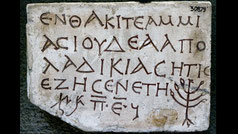
3rd-4th century. Cast of Greek white marble grave stone of Ammias from Jewish catacomb on Via Portuense, Monteverde, Rome. An engraved representation of the menorah with Greek an Hebrew text: "Here lies Ammias, a Jewess from Ladikia [Laodicea] who lived 85 years. Peace". Source: Link1, Link2, Link3, Link4, Link5
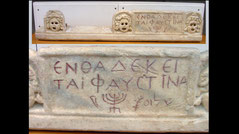
3rd century. Detail of sarcophagus lid which contains three heads (theatre masks) and Greek inscription, "Here lies Faustina". The menorah is also depicted near the inscription along with lulav and shofar. Alongside the Jewish term "shalom" (Peace). Rome, near Porta S. Sebastiano. Source: Link1, Link2, Link3
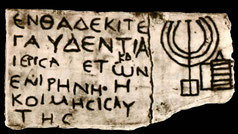
3rd-4th century. Marble grave stone from the catacomb Monteverde. Text: "Here lies Gaudentia, the priestess, [aged] 24 years. In peace her sleep." Even though the role usually assigned to Gaudentia by historians is that of a member (wife or daughter) of a priestly family, the literal translation of hierisa is "priestess." Menorah and ark on right side. Source: Link1, Link2, Link3, Link4

3rd-4th century. Tomb stone from a catacomb of Monteverde. Example of tomb of the early Christian or Hebrew era in Greek: this one with the Menorah, the characters are still irregular. Translation: "Here lies Symmachos, Gerousiarch, a Tripolitan, aged 80 years. In peace his sleep." The title of gerousiarch described the important office of president of the governing body (Council of Elders) of the congregation. Catacombsociety.org. Source: Link1, Link2, Link3, Link4
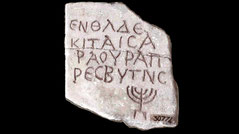
3rd-4th century. Tombstone of Sara: Elder of Elderly, from a catacomb of Monteverde. Translation: "Here lies Sara Oura, presbytes." The title "presbytes" (probably presbytis) means either elder or elderly woman. However, Müller (1919) translates the last section as "the old woman." Catacombsociety. Source: Link1, Link2, Link3, Link4

3rd-4th century. Grave brick fragment with manufacturer’s stamp and painted menorah. Terracotta. Size: high 0.29 m, wide 0.40 m, thick 0.045 m, fragmented at the left underneath corner and at the upper edge decomposed by moisture. It was found on December 5, 1904, catacomb of Monteverde, Rome. Source: Link1, Link2

3rd-6th century. "Epitaph of Flavia Antonina", from catacombs of Monteverde, Rome. With menorah, Iulav and the shofar. Text: "Here lies Flavia Antonia, wife of Dativus, (funktionary) for life in the synagogue of the Augustensians". Exhibition at Archaeological Museum of Naples. Source: Link1, Link2, Link3

3rd century. Greek inscription on the funerary slab with the representation of a menorah. From the catacombs of Monteverde, Rome, Italy. Text: "Here lies Pomponius, twice Archon of the Calcaresian Synagogue. He lived 60 years. In peace his sleep." Museo Nazionale Romano. Source: Link1, Link2, Link3, Link4, Link5, Link6
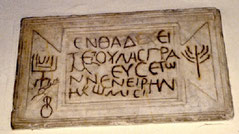
3rd-4th century. Two different seven-armed menorahs with Jewish inscription, Monteverde, Vatican Museums. International Catacomb Society. Source: Link

3rd-4th century. Epitaph of Primitiva and her grandson Euphrainon. Text: "Here lies Primitiva with her grandson Euphrenon (Euphrainon). In peace their sleep.” Monteverde catacomb. Marble. From Trastevere with etrogs (citron), lulavs (palm branch), menorahs, flasks. It concludes with the usual blessing, "May their rest (be) in peace". Città del Vaticano, Musei Vatican. Source: Link1, Link2, Link3, Link4, Link5 Link6

3rd-4th century. Circular marble inscription with seven Latin lines: "Alexander, beef-seller from the market, who lived thirty years, good soul, friend of all, your sleep amongst the just." Menorah at the bottom right. Dimensions: diameter: 32.7 cm. The catacomb on the estate of Ignace Randanini on the via Appia in Rome was excavated between 1857 and 1862, producing almost 200 inscriptions in addition to many graffiti. Photo © 2018 University of Oxford, Ashmolean Museum. Link1, Link2, Link3

3rd-4th century. Jewish sarcophagus. Place of discovery: Rome, Jewish catacomb Vigna Randanini, Mausoleum M. Material: Marble. Size: 67 x 195 x 21 cm. The relief of the strongly fragmented box front is divided into five picture fields by palm trees. In the middle there is a seven-armed candlestick (Menorah) whose four lower arms have been preserved. Jewish cult objects - ram horn (Schofar), palm branch (Lulaw) and citrus fruit (Etrog) - are depicted. Staatl. Museum Berlin. Source: Link1, Link2

3rd-4th century. Epitaph (tomb inscription), Greek marble grave stone of Judas with candelabra, palmettes, doves, flasks. The baby, who died at the age of just 7 months, was called Judah (Ioudas). Text: "Ioudas aged 7 months lies here". Found in 1904 in Rome, in the Jewish Catacombs of Monteverde on via Portuense. Kornbluthphoto. Vatican Museums, Musei Vaticani, Musei Vaticani. Source: Link1, Link2, Link3, Link4, Link5

3rd-4th century. Inscription of Ioustos with menorah on a tripod. The inscription, in poetic verse, begins with an unusual invocation from the child's adoptive father, Theodotus, who regrets not being able to lay his son in a tomb of gold; then, it goes on with a prayer to God, playing on the similarity of meaning between the child's name ("Ioustos", "right") and the Greek dikaíoma ("judgement"): "Lord, (ensure) in your good judgement that Ioustos, incomparable child, may rest in peace". Link

3rd-4th century. Detail of a marble inscription fragment from the catacomb of Randanini. In Greek: "Asterius, Archon, set up (this stone) to his parents, Asterius, Gerusiarch, and Lucina, his mother. He (the father) lived (…) years (…) In peace their sleep." Inscribed at top is a menorah and to the right is a lulav. The stone has been broken since excavation, at one time a basket of fruit and a bird were inscribed at left. Source: Link1, Link2

3rd-4th century. Fragment with Cult Symbols. On the vestige of a tombstone from Rome or Portus, a seven-branched menorah on a tripod is flanked by the traditional ritual objects, a possible lulav, an ethrog, and an amphora. Greek Inscription. It reads, “Here lies Je...” Musei Vaticani, Inventar No. 30874. Catacombsociety.org. Source: Link1, Link2, Link3, Link4

3rd-4th century. White marble top. Size: high 0.36 m, width 0.36 m, thickness 0.022 m. Found on November 23, 1904 among the rubble in Grotto V in the catacomb Monteverde. The inscription with chandelier (menorah) is carved in raw. The stonemason did not act carefully and made two spelling mistakes. Translation: "Here lies Epigenius. He should rest in peace!" Source: Link

3rd-4th century. Jewish catacomb of Monteverde with menorah. The Secretary of the Congregation, text: "Donatus, grammateus of the Vernaclians." The grammateus or scribe was charged with the secretarial duties of the Roman congregation. The name of this synagogue indicates that its founders were born in Rome. Catacombsociety.org. Source: Link
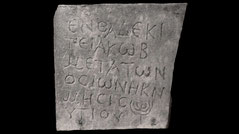
3rd-4th century. Tombstone of Jacob from the catacomb Monteverde with menorah and the following Greek inscription (translated): "Here lies James (Iakob). His rest should be with the saints." Gray marble top. Size: high 0.29 m, wide 0.31 m, thick 0.024 m, found on November 16, 1904. Source: Link
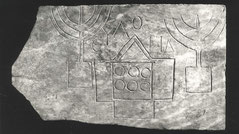
3rd-4th century. This tomb slab of gray marble was found in the Jewish catacomb on Monteverde. The engraved name is "Eulogia." Between two menorahs stands the Torah Shrine. On the inscription are two menorah flanking an ark with six scrolls. The world Eulogia may mean "Benediction." Size: high 0.255 m, wide 0.455 m, thick 0.02 m. Source: Link1, Link2, Link3
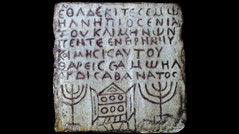
3rd-4th century. Tomb slab of white marble, found in the Jewish catacomb on Monteverde, Rome. The Torah shrine (Ark) with 6 scrolls in the center, the menorahs on its sides and the memorial inscription in Greek: "Here lies the boy Semoel, an underage child of 1 year and 5 months. In peace he is resting! Be persistent, Semoel, there is no human immortal." Source: Link1, Link2, Link3

3rd-4th century. White marble top from the catacomb of Monteverde. Text: "Here lies Ioudas, the priest [or: "from the priestly family"]." As for the office of priest, the esteem bestowed upon the descendants of the family of Aaron continued as a tradition just as it does today. In Rome their main activity was to deliver benedictions; however, the inscription that immediately follows indicates that the office did not exclude the performance of other duties. Source: Link1, Link2

3rd-4th century. Detail of two marble inscriptions from the Catacomb of Monteverde LEFT: In Greek: " Here lies Flavius Sabinus, Life Archon of the Synagogue of the Volumensians. In peace their sleep." Menorah at bottom. RIGHT: In Greek: " Here lies Eusebius, (Archon?), aged 23 years. In (peace?) his sleep." Menorah at bottom. Terme Museum. Photo: Museo Nazionale delle Terme. Source: Link, Link2

3rd-4th century. Rome, exact location unknown. Greek inscription: "Here lies Doris, peacefully her sleeping" (literally: "in peace her in sleep falling"). Musei Vaticani, Inventar No.: 30885. Image from the German book "Im Licht der Menora: Jüdisches Leben in der römischen Provinz" (2014) by Raphael Gross, Sven Hansen, Michael Lenarz, Patricia Rahemipour. Source: Link

3rd-4th century. Unusual gravestone from the catacomb Monteverde. Menorah with rectangular arms. Museo Pio Cristiano. Source: Link

3rd-4th century. Catacomb Monteverde marble menorah. Latin inscription: " Jovinus, who lived 35 years." Dimension: 14x18,5 cm. Musei Vaticani, Inventar No.: 30823. Image from the German book "Im Licht der Menora: Jüdisches Leben in der römischen Provinz" (2014) by Raphael Gross, Sven Hansen, Michael Lenarz, Patricia Rahemipour. Source: Link

3rd-4th century. A moving Epitaph from Jewish catacomb of Monteverde, Rome. On a opistograph bearing a pagan inscription, the second side describes young friendship and tragic coincidence: "Here lie Fortunatus and Eutropis, children who loved each other. Fortunatus lived 3 years and months, and Eutropis who lived 3 years and 7 months. In peace their sleep. They died on the same day." Along the bottom: amphora, menorah, shofar and lulav. Source: Link1, Link2, Link3, Link4

3rd-4th century. Detail of a marble inscription found in the Trastevere region around the Catacomb of Monteverde. In Greek with Latin Translation. "Hic est positus Tubias Barzaharona et Paregorius filius Tubiae Barzahorona", "Here lies Tubias Barzaharona and Paregorius son of Tubias Barzaharona. In Hebrew: "Peace, Peace, Peace." With menorah. In the Terme museum. Photo: Museo Naz. Terme. Source: Link1, Link2

3rd-4th century. Detail of an inscription from the Catacomb of Monteverde. In Greek: "Here lies Euphasius, Archsynagogus, who (lived a good life?)." Menorah on right. Source: Link

3rd-4th century. Sabbatius Inscription. Detail of a marble inscription from the Catacomb of Monteverde, now in the Lapidary museum-Monastery of St. Paul's Outside the Walls. In Greek with Hebrew at bottom: "Here lies Sabbatius, twice Archon. He lived 35 years. Peace on Israel". A shofar, menorah, and lulav are at bottom. Source: Link

3rd-4th century. Marble inscription from the Catacomb of Monteverde. In Greek: "Pious Anastasia lies here." Menorah at top. Terme museum. Source: Link
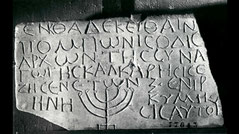
3rd-4th century. Marble inscription from the Catacomb of Monteverde. LEFT: (Frey #384, Noy #165) In Greek: "Here lies Pomponius, twice Archon of the Synagogue of Calcaresis. He lived 60 years. In peace his sleep" Menorah at bottom (Terme museum # 77643). Catacomb Society. Source: Link

3rd-4th century. African marble top. Size: high 0.23 m wide 0.45 m, found on December 9, 1904 in the Grotto V (catacomb Monteverde) under debris. The inscription and the menorah are engraved. Greek text, translated: "Here lies in the grave: Euporios with your son Sabbatios." Source: Link1, Link2, Link3
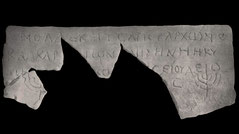
3rd-4th century. Grave stone inscription with two seven-armed menorahs from the catacomb Monteverde. Text: "Here lies Aper, Archont the Kalkarian (lime burner). Rest in peace! The son .. built it (?)" Illustration from the German book from 1919 by Nikolaus Müller "Die Inschriften der jüdischen Katakomben am Monteverde zu Rom / entdeckt und erklärt von..." Source: Link

3rd-4th century. Stone from the catacomb of Monteverde with menorah. Inscription: "Here lies Sabbasa, an underage child. Rest in peace!" Source: Link

3rd-4th century. Menorah figure on the tombstone of the catacomb Monteverde with a very sad text: "Oh, that I, Justus, could have put you in a golden coffin, I who raised you. Now, Lord, let him rest in peace, the Justus, the tender, incomparable child, in your righteousness! Here I am, Justus, 4 years 8 months old, the sweet darling of his breadwinner." Source: Link

3rd-4th century. Menorah on a tomb from the catacomb of Monteverde. Text: "Here lies Kailios Anastis, an underage child. In peace you may rest!" White marble top. Size: height 0.25m, width 0.42m, broken into two pieces. The plate was found in 1904 Source: Link
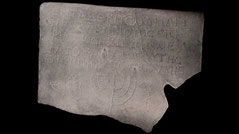
3rd-4th century. Tombstone of Mary (Maria) with a menorah from the catacomb Monteverde. The inscription is an encouragement for married couples and shows an old love: "Here lies Mary, wife of Salutios, who (she) lived in a beautiful community with her husband. She should rest in peace!" Source: Link
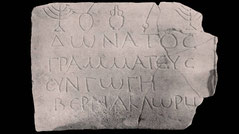
3rd-4th century. Grave plate of white marble from the catacomb of Monteverde. Text: "Donatus, secretary of the synagogue of the Bernakler." Size: high 0.31 m, wide 0.44 m and thick 0.03 m, broken into 5 pieces and eaten by moisture at its lower edge. The fragments were discovered on October 23 and 24, 1906. Source: Link1, Link2

3rd (or 2nd) century Grave plate with menorah from the catacomb Monteverde. Plate of white marble spotted with single black stripes. Text: "Flavius Contantius, who lived 23 years, 14 days." Dimensions: high 16.5 cm, wide 29.5 cm, thick 0.2 cm, consisting of 3 pieces and fragmented on the lower side. It was found in October 1906. Illustration from the German book by Nikolaus Müller (Leipzig 1919), title: "Die Inschriften der jüdischen Katakomben am Monteverde zu Rom, entdeckt und erklärt..." Source: Link

3rd-4th century. Jewish catacomb of Monteverde. Inscription: "Here lies Eusebios in the underage age of 5 years." Illustration from the German book from the year 1919 by Nikolaus Müller (1857-1912). Title: "Die Inschriften der jüdischen Katakomben am Monteverde zu Rom..." Source: Link

3rd-4th century. Jewish marble tombstone of Marinus and Justa, decorated with a menorah and other Jewish symbols and inscribed in Greek "The tomb of Marinus and Yusta his wife." The deceased were apparently wealthy Jews from Syria or Phoenicia who requested to be buried in the prestigious cemetery of Beth She‘arim. Dimensions: H. 37 cm, W. 18 cm. Israel Antiquities Authority, Photo © The Israel Museum, Jerusalem / by Nir Bareket. Source: Link1, Link2

3rd-4th century AD (AD 201-400). Monumental inscription. Ashmolean Museum of Art and Archaeology, Oxford; Accession no. AN2007.55. Source: Link

3rd-4th century AD (AD 201-400). Monumental inscription. Ashmolean Museum of Art and Archaeology, Oxford; Accession no. AN2007.59. Source: Link

3rd-4th century AD (AD 201-400). Monumental inscription. Ashmolean Museum of Art and Archaeology, Oxford; Accession no. AN2007.62. Source: Link

3rd-4th century AD (AD 201-400). Monumental inscription. Ashmolean Museum of Art and Archaeology, Oxford; Accession no. AN2007.53. Source: Link

3rd-4th century AD (AD 201-400). Monumental inscription. Ashmolean Museum of Art and Archaeology, Oxford; Accession no. AN2007.57 Source: Link

3rd-4th century, Rome. Tombstone with symbol of Christ and pagan formula. The name of the dedicant Soricio (Soricius) is derived from sorex “mouse”; the woman (his wife?) has a name derived from the Bible (the feminine form of the prophet’s name Elias). Latin cross with the vertical axis constituted by the Greek letter Ρ. The unusual appearance of the horizontal arm, curved upwards, seems to evoke the image of the Jewish seven-branched candelabrum (the menorah). Vatican Museum. Source: Link

3rd-7th century. Not far from the Porta della Montagna of Noto Antica there is a small catacomb called "delle Cento Bocche", datable around 500 AD. Among the cavities, the "Grotta del Carciofo" presents two engravings of the Jewish menorah (photo), exchanged by the local farmers for artichokes. The presence of the tomb testifies to the existence of a Jewish community in Noto (Latin: Netum; Greek Neetum, Νέητον), was a considerable ancient town in the south of Sicily, Italy. Source: Link
Menorah Pictures from other Centuries:
Until the 1st, 2nd, 4th, 5th, 6th-10th, 11th-13th, 14th, 15th, 16th, 17th, 18th, 19th, 20th, 21st Century
Note: It's nice to see the menorah pictures. However, according to the Bible Jesus (Hebrew Yeshua) is the true spiritual meaning behind the physical Menorah. He is the true and eternal spiritual
light: "I am the light of the world. Whoever follows me will never walk in darkness, but will have the light of life" (John 8:12). The menorah also symbolizes the Tree of Life, because
Jesus is the way to life: "I am the way, and the truth, and the life. No one comes to the Father except through me" (John 14:6). Jesus' Word and the Bible are the light in this world. "Your word is a lamp to my feet and a light to my path" (Ps
119:105 and John 1:1-17).
Copyright info and disclaimer: All content and all photos from ancient and new menorahs provided on this website is for informational purposes only. It is not allowed to publish photos from this website on other websites or printed literature. Please always use only the original sources of the photos. We make no representations as to the accuracy or completeness of any information on this website or found by following any link on this website. We will not be liable for any errors or omissions in this information. We will not be liable for any losses, injuries, or damages from the display or use of this information. We can not guarantee the validity and accuracy of the information, please always check the original source. The opinions expressed from other website owners and those providing comments are theirs alone, and do not reflect the opinions of us.





